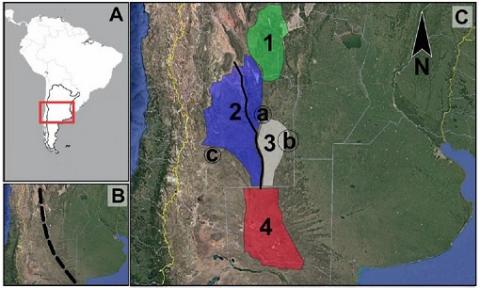Guillermo Heider, Esteban G. Jobbágy, Alfonsina Tripaldi
2 019
BOL. SOC. GEOL. MEX. 2019 VOL. 71 NO. 2 P. 229 ‒248
Las sociedades humanas que habitaron las zonas áridas y semiáridas de todo el planeta han tenido en el pasado, igual que en la actualidad, al agua como un recurso crítico en su toma de decisiones. Desde las ciencias humanas y naturales se han hecho aportes para comprender los patrones de uso del espacio de estos grupos y el manejo (en un sentido amplísimo del término, desde lo estrictamente económico a lo simbólico) que tuvieron del recurso hídrico. En este trabajo buscamos entender el uso del espacio y la movilidad de los grupos humanos que habitaron un sector de la Diagonal Árida Sudamericana ubicado en el centro de Argentina, desde la interface de las ciencias geológicas, hidrológicas y ecológicas. El área de estudio fue conocida como “Las Travesías” desde el tiempo de contacto hispano-indígena debido a las dificultades que imponían para atravesarla, la carencia de agua y el bajo poblamiento. Esta noción europea del paisaje resulta inapropiada a la luz de las evidencias arqueológicas de pueblos originarios en el territorio desde hace ca. 8000 años AP, que indicarían la presencia de recursos hídricos previamente subestimados. Combinando el análisis geomorfológico e hidrológico de los paisajes de dunas prevalentes en gran parte de Las Travesías con las evidencias arqueológicas y etnográficas existentes, proponemos un modelo de ocupación del espacio de la región con mayor déficit hídrico de Sudamérica, en el que estos paisajes funcionaron como eco-refugios. Estos sistemas de dunas suelen albergar aguas subterráneas de bajo contenido de sales y poca profundidad, gracias al alto drenaje del sustrato arenoso que permite que una fracción apreciable de las lluvias, aun en climas áridos, escape de la evapotranspiración y recargue el acuífero freático. Evidencia actual y etnográfica sugiere que la ocupación y disturbio persistente de estos sistemas de dunas aumenta su capacidad de proveer agua al deteriorar la cubierta vegetal y así (i) restringir la evapotranspiración y aumentar la recarga y (ii) deprimir zonas del terreno por erosión, acortando la profundidad al manto freático. Un conjunto relativamente limitado pero eficiente de estrategias para la cosecha de agua, sumado a una movilidad estacional y el conocimiento profundo del espacio, se plantean como estrategias que permitieron no solo la exploración y colonización inicial de Las Travesías sino, posteriormente también, su ocupación definitiva.
Who inhabited the arid and semi-arid zones of the entire planet have had water as a critical resource in their decision-making. From the human and natural sciences, contributions have been made to understand the patterns of the use of space of these groups and the management (in a very broad sense of the term, from the strictly economic to the symbolic one) of the water resource. The aim of this work is to understand the use of space and mobility of the human groups that inhabited a sector of the Arid South American Diagonal, located in the center of Argentina, from the interface of the geological, hydrological, and ecological sciences. The study area was known as “Las Travesías” from the time of the Hispanic-Indigenous contact due to the difficulties of crossing it, because of the lack of water and the low population. This European notion of the landscape is inappropriate in the light of the archaeological evidence of indigenous peoples in the territory since ca. 8000 years BP. These occupations suggest the presence of previously underestimated water resources. Combining the geomorphological and hydrological analyses of the dune landscapes, prevalent in a large part of Las Travesías, with the existing archaeological and ethnographic evidences, we propose a model of space occupation with greatest water deficit in South America and, in which, these landscapes have functioned as eco-shelters. These systems of dunes tend to hold groundwater with low salt content and shallowness due to the high drainage of the sandy substrate that allows a considerable fraction of the rains, even in arid climates, escape evapotranspiration and recharge the phreatic aquifer. Modern and ethnographic evidence suggests that the persistent occupation and disturbance of these dune systems increases their ability to provide water by damaging the vegetation cover, restricting evapotranspiration, increasing recharge, and depressing areas of the land by erosion, shortening the depth to the water table. A relatively small but efficient set of strategies for harvesting water, together with seasonal mobility and a deep knowledge of the space, are proposed as the strategies that allowed not only the exploration and initial colonization of Las Travesías but also the definitive occupation of this space.

